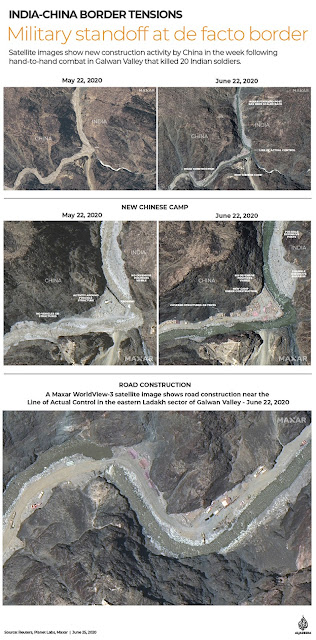Gulwan Valley | China starts adding new infrastructure , India worried
China has added new infrastructure in the Gulwan Valley area of Ladakh near the area that recently clashed with India
According to foreign news agency Reuters, the new satellite images give an idea of China's new infrastructure, and this development has raised fears of a clash between the two nuclear-armed neighbors.
Stubdan, a former Indian diplomat and Ladakh affairs expert, told the British News Agency that the construction was disturbing. The Indian government has neither released a statement nor issued a statement, so it is difficult to make any guesses, but photos released by a private firm show that China has built there and is not far behind. Have gone The situation in the region is still described as
very tense
It may be recalled that the Indian and Chinese military commanders in Monday's talks had agreed to withdraw from several places along the disputed border after a bloody clash in the Gulwan Valley.
The satellite images of new construction activities by China in the region come a week after a June 15 clash in which 20 Indian soldiers, including a colonel, were killed.
Chinese construction activities point to a new challenge that could push the two countries out of talks and threaten to fail to reach a possible agreement on the disputed desert.
Images taken by Maxar Technologies, a US-based space technology firm, show China's vast infrastructure on the banks of the Gloucester River.
According to the news agency, India has accused China of constructing new structures in its territory near the unclear Line of Actual Control (LAC).
According to Reuters, China claims the entire Gloucester Valley and blames Indian troops for starting the clashes. The photos show China's new construction activities, including camouflage tent or rock-covered structures and the walls or bunkers of a possible new camp a short distance away. The camp was not visible in photos available to Reuters last week.
Nathan Rosser, a satellite data expert at the Australian Strategic Policy Institute, said the construction showed there was no prospect of easing tensions in the region.
He wrote in a post on the social networking site Twitter that satellite images taken on June 22 in the Gulwan Valley show that disengagement is not really the word that the Indian government should use.
The pictures also show some additional steps taken by India. The latest photos show India's defense barriers, which were not visible in the May photos.
From the latest photos, it seems that the Indian forward post has been removed, which was seen in the photos taken a few months ago.
The Chinese Foreign Ministry declined to immediately comment on the construction activity.
On the other hand, the Indian Ministry of Defense did not respond to a request for comment.
Indian military officials have previously said they would closely monitor the implementation of the disarmament agreement and verify it on the ground.
Former Indian Army Chief Deepak Kapoor says that as far as the Chinese are concerned, we do not trust them. Although they (China) are verbally telling us that they are ready to retreat, we will wait to see the practical evidence on the ground. Until then, our armed forces will remain vigilant.
It begins at the confluence of the Gulwan and Shiwak rivers, and is located east of the confluence of these rivers in the valley, which the two sides formally recognize as the Line of Actual Control.
It should be noted that 20 Indian soldiers were killed in a physical clash between the Chinese and Indian armies and this is the bloodiest clash between the armies of the two countries in 45 years.
According to experts, the chances of a direct war between the two countries are very low, but it may take some time for tensions to subside.
China is claiming that its 90,000 square kilometers area is located in India, in response to which India has claimed that its 38,000 square kilometers area is located in the mountainous region of Aksai Chen within China's borders.





Comments
Post a Comment